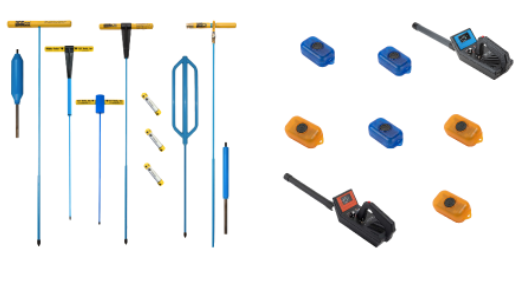Blog Blog
Choosing the Right Tool: Metal Soil Probe vs. Ardy and Ferris Analog Receivers for Locating Septic Tanks and Non-Metallic Lines
May 31, 2024
Choosing the Right Tool: Metal Soil Probe vs. Ardy and Ferris Analog Receivers for Locating Septic Tanks and Non-Metallic Lines
May 31, 2024Article Originally Seen on Varco Pro Supply
Locating septic tanks and underground items is a crucial aspect of property maintenance, construction, and utility work. Whether you’re a homeowner needing to identify the location of your septic system or a contractor planning an excavation project, having the right tools for the job is essential. Two commonly used tools for this purpose are metal soil probes as well as Ardy and Ferris analog receivers. In this blog post, we’ll explore the strengths and limitations of each tool and provide guidance on selecting the most suitable option for locating septic tanks.
Metal Soil Probe:
Both the Mighty Probe and Smart Stick are steel soil probes that are great for locating items underground like septic tanks. They provide the rigidity of a steel probe, and the insulated probes provide you with that extra layer of protection from the potential of electric shock.
Here are some key features of metal soil probes:
Versatility
Metal soil probes can be used to locate a variety of underground structures, including septic tanks and other underground tanks. Their versatility makes them a valuable tool for both homeowners and contractors.
Ease of Use
Using a metal soil probe is relatively straightforward. Simply insert the probe into the ground and prod, looking to make contact with the underground tank. With a bit of practice, users can quickly become proficient in using this tool.
Cost-Effectiveness
Metal soil probes are generally affordable and accessible, making them a cost-effective option for homeowners and small businesses. Compared to more advanced technologies, such as ground-penetrating radar, metal soil probes offer a budget-friendly alternative for basic locating tasks.
Limitations
While metal soil probes are effective for detecting underground tanks, they may struggle to locate lines buried deep beneath the surface. It’s also exhausting to probe for hours day after day, especially in frozen, rocky, or hard soil. Finally, probes risk damage when using in clay, or hitting Orangeburg or concrete pipes.
Ardy (223kHz) and Ferris (512Hz) Analog Receivers:
Ardy and Ferris analog receivers are sophisticated tools used for detecting underground septic tanks, cast iron and non-metallic lines. These receivers detect the signal output by the flushable transmitters as it travels from the outlet into the septic tank.
Here are some key features of Ardy and Ferris analog receivers:
Depth Detection
Depending on the receiver and transmitter being used, analog receivers have a detection depth of 8 +/- feet in cast iron, 12 +/- feet in nonmetallic, and 15 +/- feet in nonmetallic for the HTP-15 flushable transmitter, enabling users to scan areas quickly and efficiently.
Flushable transmitters
The flushable transmitters are small enough to pass through 3-inch lines. You can free-flush it through the plumbing to the tank or to the blockage, whichever comes first. When you open the tank, the transmitter with its bright flashing LED should be found floating near the inlet baffle. Once retrieved, turn it off so you can use it on the next job.
Cost
While Ardy and Ferris analog receivers may represent more of a cost upfront, their accuracy and efficiency can ultimately save users time and money on excavation projects. For pumpers/cleaners, plumbers and home inspectors, the cost of these receivers is often justified by the benefits they provide in terms of accuracy and productivity.
Choosing the Right Tool:
When it comes to choosing between a metal soil probe and an Ardy and Ferris analog receiver for locating septic tanks, cast or non-metallic lines, several factors should be considered:
Project Scope
Consider the size and complexity of the project, as well as the specific objects you need to locate. For small-scale projects or basic locating tasks, a metal soil probe may suffice. For larger projects or more complex terrain, an Ardy and Ferris analog receiver may be more suitable.
Accuracy Requirements
Assess the level of accuracy required for your project. If precise location data is essential, an Ardy and Ferris analog receiver may be the better option due to its real-time tracking capabilities and high level of accuracy.
Budget
Take into account your budget constraints and the overall cost of the tools and associated equipment. While a metal soil probe may be more affordable upfront, an Ardy and Ferris analog receiver may offer greater accuracy and efficiency, reducing on-site time to allow for more daily jobs, earning you more money in the long run.
Terrain and Soil Conditions
Consider the terrain and soil conditions of the project site. Metal soil probes may perform well in areas with relatively uniform soil composition, while Ardy and Ferris analog receivers may be better suited to challenging terrain or grounds that are frozen.
Ease of Use
Evaluate the ease of use of each tool, taking into account factors such as training requirements and user experience. While metal soil probes are generally straightforward to use, Ardy and Ferris analog receivers may require more extensive training and experience to operate effectively.
Conclusion
Both metal soil probes and Ardy and Ferris analog receivers are valuable tools for locating septic tanks and non-metallic lines buried beneath the ground. The choice between them depends on factors such as project scope, accuracy requirements, budget, terrain and soil conditions, and ease of use. By carefully considering these factors and assessing your specific needs, you can select the tool that best meets your requirements and ensures the success of your locating tasks.
Varco Pro Supply offers a variety of Probes, Locating Equipment as well as Flushable Transmitters. Give us a call today at (866) 872-1224 or visit our tool section online.